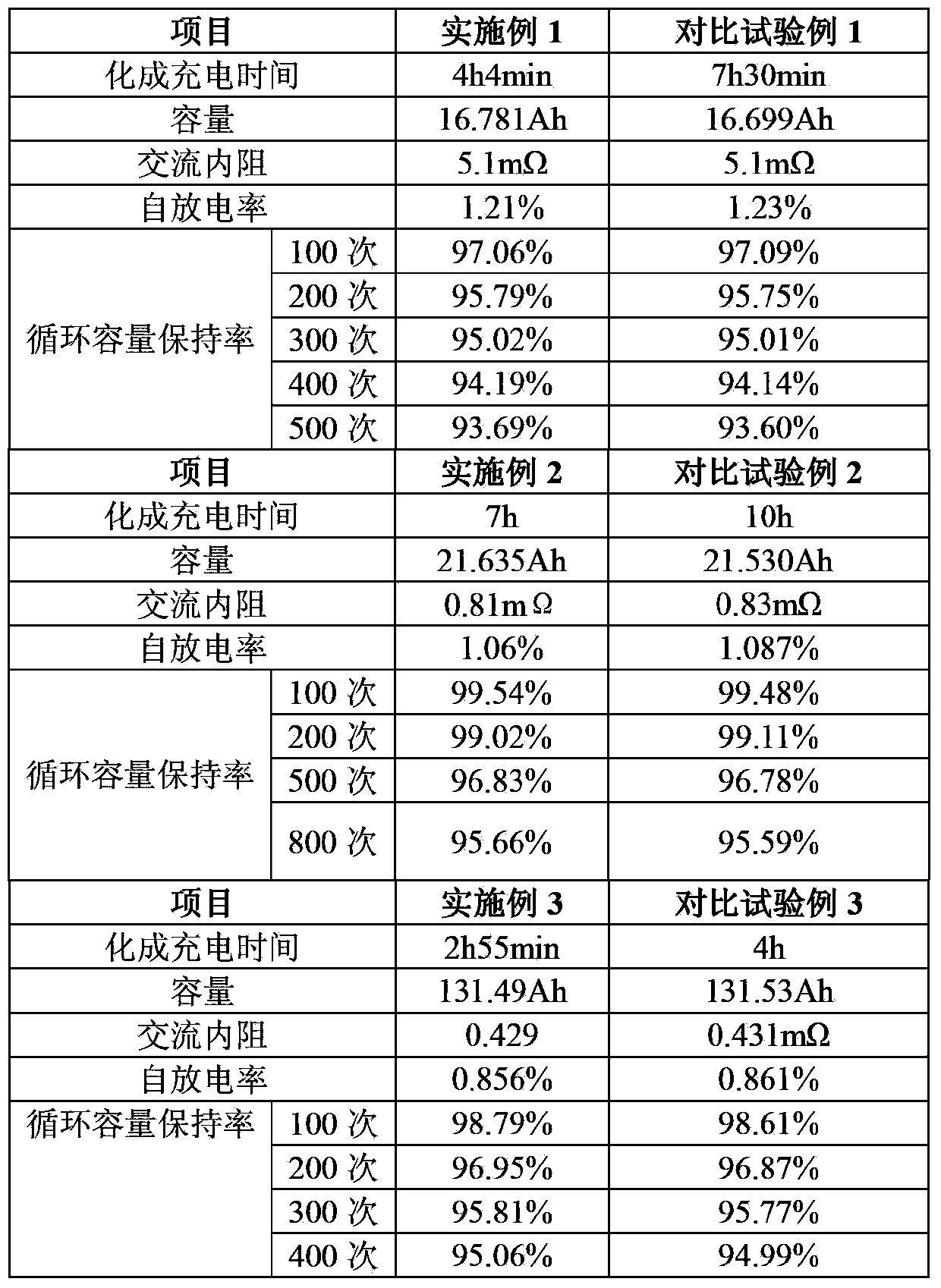Lithium ion battery formation sectional charging method
A lithium-ion battery, segmented charging technology, applied in non-aqueous electrolyte batteries, electrolyte battery manufacturing, sustainable manufacturing/processing, etc. Looseness and other problems, to achieve the effect of improving chemical charging efficiency, good cycle performance, and reducing impedance
- Summary
- Abstract
- Description
- Claims
- Application Information
AI Technical Summary
Problems solved by technology
Method used
Image
Examples
Embodiment 1
[0014] A lithium-ion power battery with lithium iron phosphate as the cathode material system with a capacity of 16.5Ah was used to form a charging process under stable room temperature conditions.
[0015] 1. Stand still: 5min
[0016] 2. Constant current charging stage 1: charging current: 0.15C, charging time: 100min;
[0017] 3. Stand still: 2min;
[0018] 4. Constant current charging stage 2: charging current: 0.5C, charging cut-off voltage: 3.57V;
[0019] 5. Stand still: 5min;
[0020] 6. Constant current charging stage three: charging current: 0.15C, charging cut-off voltage: 4.2V;
[0021] 7. Constant voltage charging stage: charging voltage: 4.2V, charging cut-off current: 0.03C;
[0022] 8. Standing: 10min.
[0023] After the completion of the formation stage, it was left at room temperature for 7 days and then charged and discharged.
Embodiment 2
[0031] The lithium-ion power battery with lithium iron phosphate as the positive electrode material system has a capacity of 20 Ah, controlling the stable room temperature conditions for the battery formation and charging process.
[0032] 1. Stand still: 10min
[0033] 2. Constant current charging stage 1: charging current: 0.1C, charging time: 180min;
[0034] 3. Stand still: 2min;
[0035] 4. Constant current charging stage 2: charging current: 0.3C, charging cut-off voltage: 4.0V;
[0036] 5. Stand still: 20min;
[0037] 6. Constant current charging stage three: charging current: 0.1C, charging cut-off voltage: 4.2V;
[0038] 7. Constant voltage charging stage: charging voltage: 4.2V, charging cut-off current: 0.01C;
[0039] 8. Standing: 20min.
[0040] After the completion of the formation stage, it was left at room temperature for 7 days and then charged and discharged.
Embodiment 3
[0048] The lithium-ion power battery with lithium iron phosphate as the positive electrode material system has a capacity of 130 Ah, controlling the stable room temperature conditions for the battery formation and charging process.
[0049] 1. Stand still: 5min
[0050] 2. Constant current charging stage 1: charging current: 0.3C, charging time: 40min;
[0051] 3. Stand still: 10min;
[0052] 4. Constant current charging stage 2: charging current: 0.6C, charging cut-off voltage: 3.5V;
[0053] 5. Stand still: 5min;
[0054] 6. Constant current charging stage three: charging current: 0.3C, charging cut-off voltage: 4.2V;
[0055] 7. Constant voltage charging stage: charging voltage: 4.2V, charging cut-off current: 0.05C;
[0056] 8. Standing: 20min.
[0057] After the completion of the formation stage, it was left at room temperature for 7 days and then charged and discharged.
PUM
 Login to View More
Login to View More Abstract
Description
Claims
Application Information
 Login to View More
Login to View More - R&D
- Intellectual Property
- Life Sciences
- Materials
- Tech Scout
- Unparalleled Data Quality
- Higher Quality Content
- 60% Fewer Hallucinations
Browse by: Latest US Patents, China's latest patents, Technical Efficacy Thesaurus, Application Domain, Technology Topic, Popular Technical Reports.
© 2025 PatSnap. All rights reserved.Legal|Privacy policy|Modern Slavery Act Transparency Statement|Sitemap|About US| Contact US: help@patsnap.com


